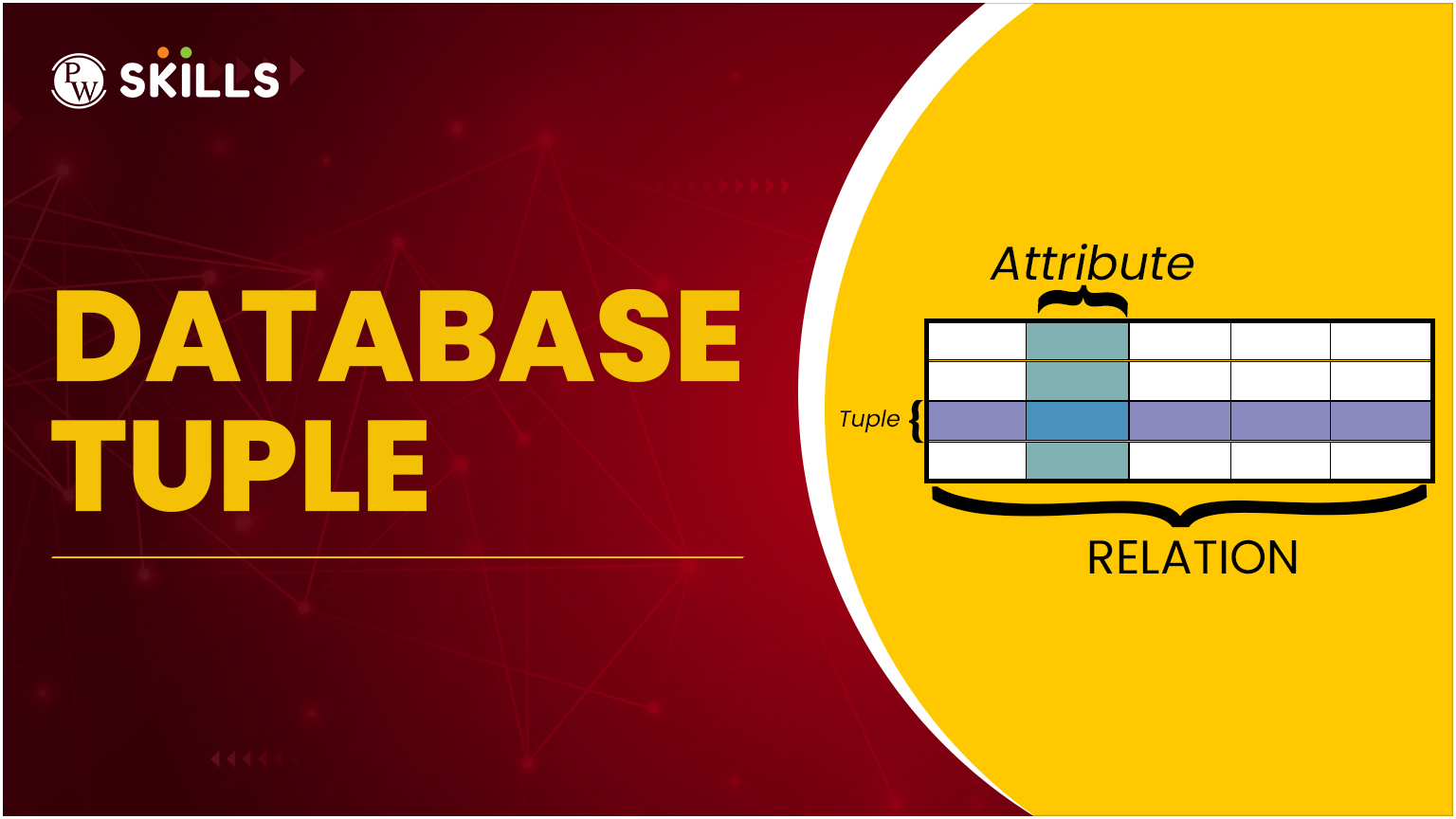You might have come across Database tuple in databases or DBMS and might find yourself confused with the tuples used in Python. However, both these tuples share significant differences. Some of us think that tuple is a name given to rows in a database, but database tuple is a set of unordered values which are known to us.
In Database Management System (DBMS) tuples are used in organising and modifying data. Let us learn more about Database tuple in this article.
What is a Database Tuple?
A Database Tuple is a concept used in DBMS which is used to represent a single record or row value in the relational database. It is important to be familiar with the basics and working of the tuples in the database. It is defined as an ordered set of values which represents a specific set of entities or objects. Each attribute inside the tuple or columns represent a value inside the tuple.

For example, suppose we have a table of “Students” in our database having attributes like “Student ID”, “Name”, “Age”, and “Marks” where a tuple in this table can be represented using the following given below.
(12, “Ankit Kumar”, 20, 100) → This entity in the DBMS is used to represent database tuple.
Features of Tuple In Database
Database Tuple refers to a single row or record present in a database. It represents a collection of data values from different attributes of a relational table. Some of the major features of database tuple are mentioned below.
- A database tuple arranges every element in an ordered set of values.
- It can be used to identify a particular set of values using the primary key and avoid duplication.
- The structure of a tuple in a database is fixed as per schema definition of relational database.
- Each attribute of a database tuple holds an atomic value which cannot be further divided into more entities.
- It follows different integrity constraints such as primary key constraints, foreign key constraints, domain constraint, not null constraint, etc.
- You can perform different operations on tuples such as INSERT, UPDATE, DELETE, SELECT, and more.
- All operations performed on tuples follow ACID properties of relational databases.
Different Operations on Database Tuple

You can always perform different operations on database tuple listed in a table. It involves various actions such as insertion, retrieving, updating, and deleting a set of values from tuples.
Inserting Tuples
Inserting a tuple involves adding a new record into a table using the INSERT statement in SQL. This operation ensures that all required attributes are provided while maintaining integrity constraints like primary keys and foreign keys. For example, INSERT INTO Students (ID, Name, Age) VALUES (1, ‘John Doe’, 20);adds a new student record.
Retrieving Tuples
Retrieving tuples involves fetching specific or all records from a table using the SELECT statement. It allows users to extract data based on conditions using WHERE, sorting with ORDER BY, or filtering with GROUP BY. For example, SELECT * FROM Students WHERE Age > 18; retrieves all students above 18 years old.
Updating Tuples
Updating a tuple modifies existing data in a table using the UPDATE statement. This operation is useful for correcting errors or changing values while ensuring consistency. For instance, UPDATE Students SET Age = 21 WHERE ID = 1; updates the age of the student with ID 1 to 21.
Deleting Tuples
Deleting a tuple removes a specific record from a table using the DELETE statement, often based on a condition. This operation should be performed carefully to avoid unintended data loss. For example, DELETE FROM Students WHERE ID = 1; removes the student record with ID 1 from the table.
Different Constraints In Database Tuple

A database tuple constraints are rules that define how tuples need to be defined in a database table. These constraints ensure that every data inside the table follows data integrity and consistency constraints.
1. Key Constraints
Key Constraints are constraints which ensure uniqueness of tuples in a table. They ensure that every specific attribute or combination of attributes in a tuple is a set of unique values within the table. No tuples in the database can have the same primary key value and it can never be NULL.
It is essential for maintaining data integrity in the relational database. For example, a primary key is used to maintain the key constraints in a table due to its uniqueness.
| CREATE TABLE Students (
ID INT PRIMARY KEY, Name VARCHAR(50), Age INT ); |
2. Domain Constraints
Domain constraints ensure that value within a tuple is in the valid range specified within the table attributes. It is used to specify the type of data, format and range of values allowed within the attribute of data. It can be very useful in maintaining data consistency and preventing invalid data from inserting in data.
3. Referential Integrity Constraints
This integrity is used to establish a common relationship between different values of tuples in a table. They are used to ensure that the foreign key values in a tuple to a primary key values in another table.
4. Entity Integrity Constraints
This constraint in the database tuple is used to ensure that the primary key value within a database tuple is not empty or null. It is used to guarantee that each tuple has a unique identifier value within the database. It maintains data integrity and prevents any unordered or incomplete data in the table.
| CREATE TABLE Orders (
OrderID INT PRIMARY KEY, CustomerName VARCHAR(50) NOT NULL ); |
Types of Database Tuple In DBMS

Let us understand how many types of database tuples are there which can be used during SQL operations.
- Candidate Tuple: A tuple that is a potential candidate to be a part of the final result set in a query but may be filtered out based on conditions.
- Base Tuple: A tuple that is physically stored in a database table and represents real-world entities. It is part of the main dataset before any query filtering.
- Derived Tuple: A tuple that is not stored directly in the database but is generated dynamically using queries, views, or computations.
- Inserted Tuple: A newly added tuple in a table through the INSERT statement, ensuring it follows integrity constraints.
- Deleted Tuple: A tuple that has been removed from a table using the DELETE or TRUNCATE statement, affecting the dataset permanently unless a rollback is applied.
- Updated Tuple: A tuple whose attribute values have been modified using the UPDATE statement while keeping its identity (primary key) unchanged.
- Active Tuple: A tuple that is currently being processed in a transaction or is involved in a query execution at a given moment.
- Temporary Tuple: A tuple stored in temporary tables or cache memory, used for intermediate calculations in complex queries or transactions.
Read more: Difference Between System Design Vs Database Design In Database
Difference Between Python Tuples and Database Tuple
A Python tuple is an ordered, immutable collection of elements used to store multiple values in a single variable. It is defined using parentheses () and can hold different data types.
Since tuples are immutable, their values cannot be changed after creation. They are mainly used for grouping related data together, improving performance, and ensuring data integrity in Python programs. A simple example is listed below for your reference.
| person = (“John”, 25, “Engineer”) # Python Tuple
print(person[0]) # Output: John |
Whereas a database tuple, on the other hand, represents a single row (record) in a table within a relational database. It consists of multiple attributes (columns) that store related data for a single entity. Unlike Python tuples, database tuples can be modified (INSERT, UPDATE, DELETE) as part of database operations. They are stored in tables and ensure data integrity through constraints.
| INSERT INTO Employees (Name, Age, Job) VALUES (‘John’, 25, ‘Engineer’);
SELECT * FROM Employees; |
Database Tuple FAQs
Q1. What is Database Tuple?
Ans: A Database Tuple is a concept used in DBMS which is used to represent a single record or row value in the relational database. It is important to be familiar with the basics and working of the tuples in the database.
Q2. What is the difference between Database tuple and Python tuple?
Ans: While both Python tuples and database tuples are stored in the database, Python tuples are immutable and exist within a memory with no much modification while tuples in DBMS are mutable and stored within a relational table.
Q3. What are different constraints in Database Tuple?
Ans: Key Constraints, domain constraints, referential integrity constraints and entity integrity constraints are some of the major constraints used in database tuple.
Q4. What is the inserting tuples operation?
Ans: Inserting a tuple involves adding a new record into a table using the INSERT statement in SQL. This operation ensures that all required attributes are provided while maintaining integrity constraints like primary keys and foreign keys.

